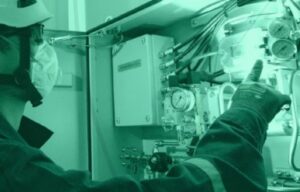
The Maritime Technologies Forum (MTF) has issued new guidelines for the safe inspection of methanol dual-fuel ships. As the maritime industry accelerates its transition to alternative fuels under increasingly stringent IMO emission regulations, methanol as fuel has emerged as a particularly attractive option, as documented by the increasing number of orders.
However, according to the Maritime Technologies Forum, methanol’s unique properties, including its flammability, toxicity, and corrosivity, present distinct challenges for ship inspectors and surveyors.
A total of 41 safety recommendations have been identified across the inspection process, representing an important effort to provide practical guidance and direction to support the industry’s safe adoption of methanol. The project was led by the Maritime and Port Authority of Singapore (MPA) with the participation of various MTF members.
The new guidelines cover the key areas of attention to ensure safe inspection:
– Pre-Inspection Preparations: Competency requirements, specialized training, thorough ship familiarization, emergency preparedness, and proper PPE selection and use.
– During Inspection Protocols: Dynamic Risk Assessment (DRA), CMES system testing, hazardous area management, methanol fuel system inspection procedures, and incident response readiness.
– Post-Inspection Considerations: Decontamination procedures, health monitoring (accounting for delayed symptom onset),
and PPE maintenance and disposal.
“The guidelines may also be applicable to other professionals who visit or board these vessels, such as for cargo handling, maintenance and repairs, deliveries, and pilotage. MPA’s participation in developing these guidelines reflects our commitment to supporting the maritime industry’s multi-fuel transition towards a cleaner, greener and safer future,” said Capt. M Segar, Chief Marine Officer/Senior Advisor, Maritime and Port Authority of Singapore (MPA).
Key recommendations pre-inspection
Inspectors competency
– Inspectors are required to complete additional training covering the characteristics/properties, hazards, routes of entry, emergency response actions, effects of methanol and effective PPE implementation for methanol.
– Inspectors are to have a good working knowledge of methanol fires, understanding the characteristics of methanol fire and methods of control and extinguishing. Inspectors are not expected to be involved in firefighting but knowledge of such the characteristics is essential for the immediate detection of a fire and the preventing of its further spread.
– Inspectors are recommended to receive some form of basic first aid instructions and be knowledgeable in the effects and first aid treatment of methanol, ingestion or inhalation or dermal exposure.
– Inspectors are to be competent in using the personal protective equipment (PPE) in particular portable gas detectors, and EEBDs set (including the checks).
In addition to inspector competency, they should also determine whether the crew holds certificates of competency or proficiency, and relevant documentation, required for operating a methanol dual-fuel ship and handling methanol.
Ship familiarization
– Prior to boarding a ship, the inspector should utilise every available resource to become familiar with the ship and its purpose. Such resources may include for example Classification Society records, Port State Control Records, IMO GISIS, Equasis or Sea-Web.
– A Safety briefing and toolbox talk is to be held on board with ship’s crew and ship safety officer. This safety briefing is to include:
-The ship’s emergency response arrangements with identification of muster point, escape routes and audio/visual warning.
– Identification of all hazardous zones and the probability of methanol release in those areas.
– All ongoing work on board such as equipment maintenance, cargo operations, bunkering, loading of stores etc.
– All areas of the ship where Methanol is stored, transferred, treated or combusted. Such areas will include bunker storage tanks, tank connection space, fuel preparation room, bunkers stations and engine rooms.
– Inspectors should be aware that due to proximity contamination, methanol may have contaminated other areas or systems which may not normally be associated with the use of methanol.
– Awareness of ship’s design, layout and Alternative Design & Arrangements (AD&A) if any, and understanding of its designated safeguards.
– Identify enclosed spaces onboard and whether scope of inspection would be in these areas.
Emergency awareness and preparedness
– Inspectors should be familiar with ship’s emergency alarms, emergency exits and the emergency response plans (ERP).
– Inspectors should follow any specific safety instructions given to them during an emergency.
– Inspectors should make themselves aware of the location of any safety equipment/facilities such as eye wash stations and decontamination stations onboard or in the vicinity of the locations where they will be inspecting.
– Inspectors should know how to respond if they are inadvertently caught in methanol fire, such as the stop, drop, and roll technique and remove contaminated clothing when safe to do so.
Personal protection equipment (PPE)
– All inspectors should be trained and competent in the proper use of personnel protective equipment (PPE).
– Inspectors should check and ensure their PPE is in good working condition.
– In addition to the standard PPE, the inspector should carry a properly functioning and calibrated intrinsically safe personal gas detector in accordance with the applicable standards and functions as follows:
– Low Oxygen Concentrations
– Methane
– High Carbon Monoxide Concentrations
– The meter should also be suitable for use in hazardous areas and provide at least three means of alerting the user such as Light Emitting Diode (LED) lights, vibration and audible tone.
– PPE should be properly maintained and promptly cleaned if suspected of contamination.
– All PPE should be manufactured to international standards and have flame retardant and antistatic properties. Inspectors should be aware that these properties may degrade with time and number of washes.